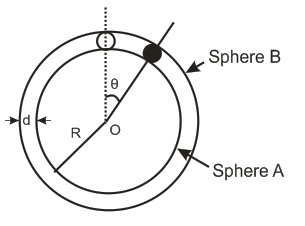Newton's Ball!
 A spherical ball of mass
is kept at the highest point in the space between two fixed concentric spheres
and
. The smaller sphere
has a radius
and the space between the two spheres has a width
. The ball has a diameter very slightly less than
. All surfaces are frictionless. The ball is given a gentle push towards the right . The angle made by the radius vector of the ball with the upward vertical is
. What is the total normal reaction force exerted by the spheres on the ball in terms of angle
?
A spherical ball of mass
is kept at the highest point in the space between two fixed concentric spheres
and
. The smaller sphere
has a radius
and the space between the two spheres has a width
. The ball has a diameter very slightly less than
. All surfaces are frictionless. The ball is given a gentle push towards the right . The angle made by the radius vector of the ball with the upward vertical is
. What is the total normal reaction force exerted by the spheres on the ball in terms of angle
?
This section requires Javascript.
You are seeing this because something didn't load right. We suggest you, (a) try
refreshing the page, (b) enabling javascript if it is disabled on your browser and,
finally, (c)
loading the
non-javascript version of this page
. We're sorry about the hassle.
Velocity of the ball at angle θ is
Let N be the normal reaction (away from the centre.....there is only one centre) at angle θ . Then...........
Substituting the value of v 2 ..... we get ......
This is my solution.....if anyone finds any error please feel free to correct me !!!!!
Enjoy And Learn !!!!!